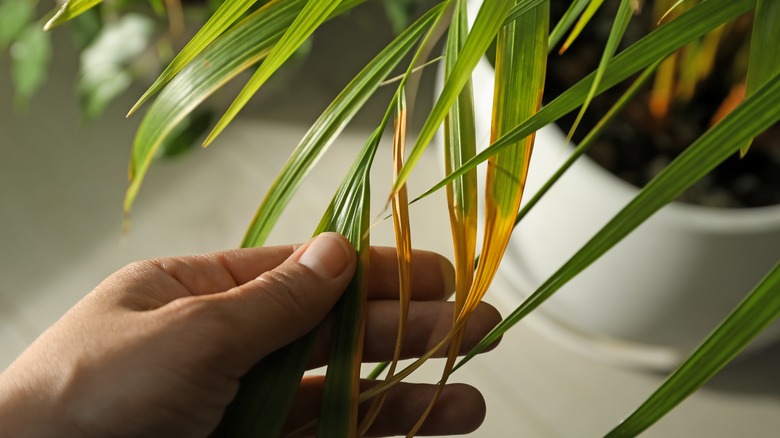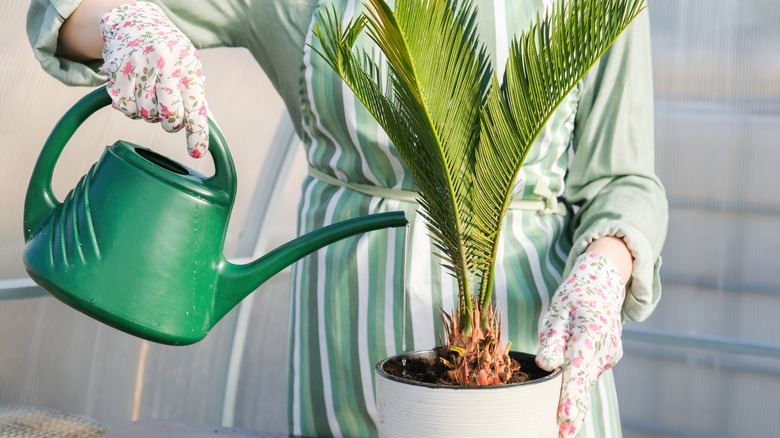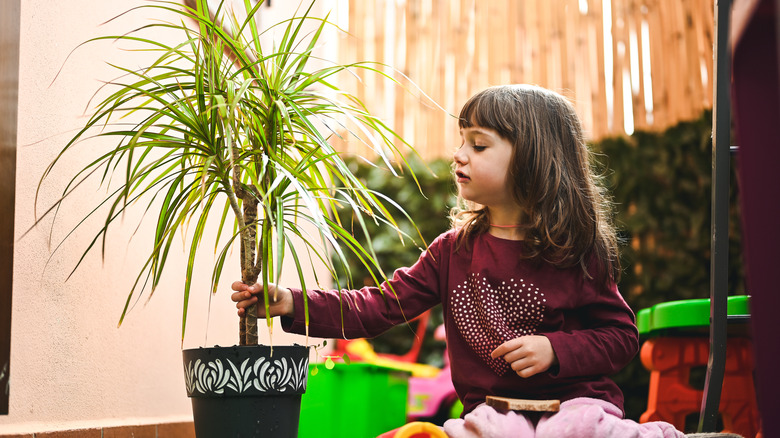Palm Plant Leaves Turning Brown? You're Likely Making This Big Mistake
There's no better joy than having a house full of healthy plants — or better yet, houseplants that are good for your health. With a set watering schedule, consistent root checks, and fertilizer when needed, plants have no choice but to thrive, right? Unfortunately, the real answer is no. Even the most cared for houseplants can have issues including, but definitely not limited to, brown leaves.
Your palm plants, in particular, may have this issue. First things first, don't beat yourself up. Not every season is for thriving, even if you're doing everything right. Palm plants are known for having browning leaves at the end of their lifecycle. If new foliage is replacing the decaying leaf then this cycle is natural. You should simply grab your pruning supplies and cut the brown leaf as close to its stem as possible. Pro tip: Try your best not to remove more than 30% of the plant while pruning, as this can shock — and ultimately kill — the plant if too many leaves are gone at one time.
But if your brown leaves aren't being replenished with new growth, it's time to consider other reasons why your palm may be browning. It may have everything to do with light availability, water quality, or a weather injury.
How water may be negatively impacting your palm
A watering schedule is a plant's lifeline, but it can also be a major source of sickness, too. Your palm may be browning due to a lack of drainage. If there isn't a proper drain hole at the bottom of your plant pot, the excess water can lead to root rot and drought stress. According to the University of Maryland Extension, overwatered houseplants had reduced oxygen and suffered from root damage that impacted their ability to properly take in water. The cellular damage will call for constant rehydration, considering the plant is now in need of more moisture than ever.
Take a look at your watering schedule. On average, palms should be watered two to three times a week, but always follow the 50% rule. If 50% of your palm's soil is dry, water it and be sure to dispose of any excess water. If your watering schedule isn't the cause of browning, consider a toxicity test.
Most tap water contains high levels of salt that can have negative impacts on your soil's ability to be absorbed and drain properly. Palm's Online states that a palm's PH level should be between 6.0 and 7.0. Be warned: Other factors like soils and fertilizers may also be disturbing your plant's pH. This can be fixed by leeching the soil, though. Pour water onto your palm three to four times, allowing all of the water to completely run out. Repeat this step to decrease the salt and phosphate content.
How a weather injury may be the cause of your browning palm
Though water injuries can have long-term effects on a plant's health, a weather injury can make a big impact immediately. Palms need warm temperatures to grow properly, so maintaining high humidity levels that mimic a tropical climate is key. Temperatures below 45 degrees Fahrenheit will create cold wounds that cause a reddish-brown decay in a matter of days. This can be especially difficult in the winter months, but you can make minor changes like moving your palm away from the AC.
If you can't adjust the temperature in your home to aid your palm, consider a pebble tray to create humidity that will increase your plant's health. Nurseries recommend filling the bottom of your palm pot with pebbles (be decorative if you'd like), adding only enough water to cover the bottom halves of the pebbles, then setting your palm on top of the pebble mixture. Place your drainage pot underneath. Also consider adding natural humidity to the space by bringing tropical plants a bit closer together. Because they naturally transpire, being closer in proximity can be helpful. Placing your palm in the shower or getting the perfect room humidifier can also be extremely beneficial.
Once you evaluate all the reasons why your palm could be browning, make the necessary changes. The little things could have a bigger impact on your other houseplants, as well. With the right mindset, some quality shears, and a new routine, we're sure your palm will be in tip-top shape just in time for spring.


